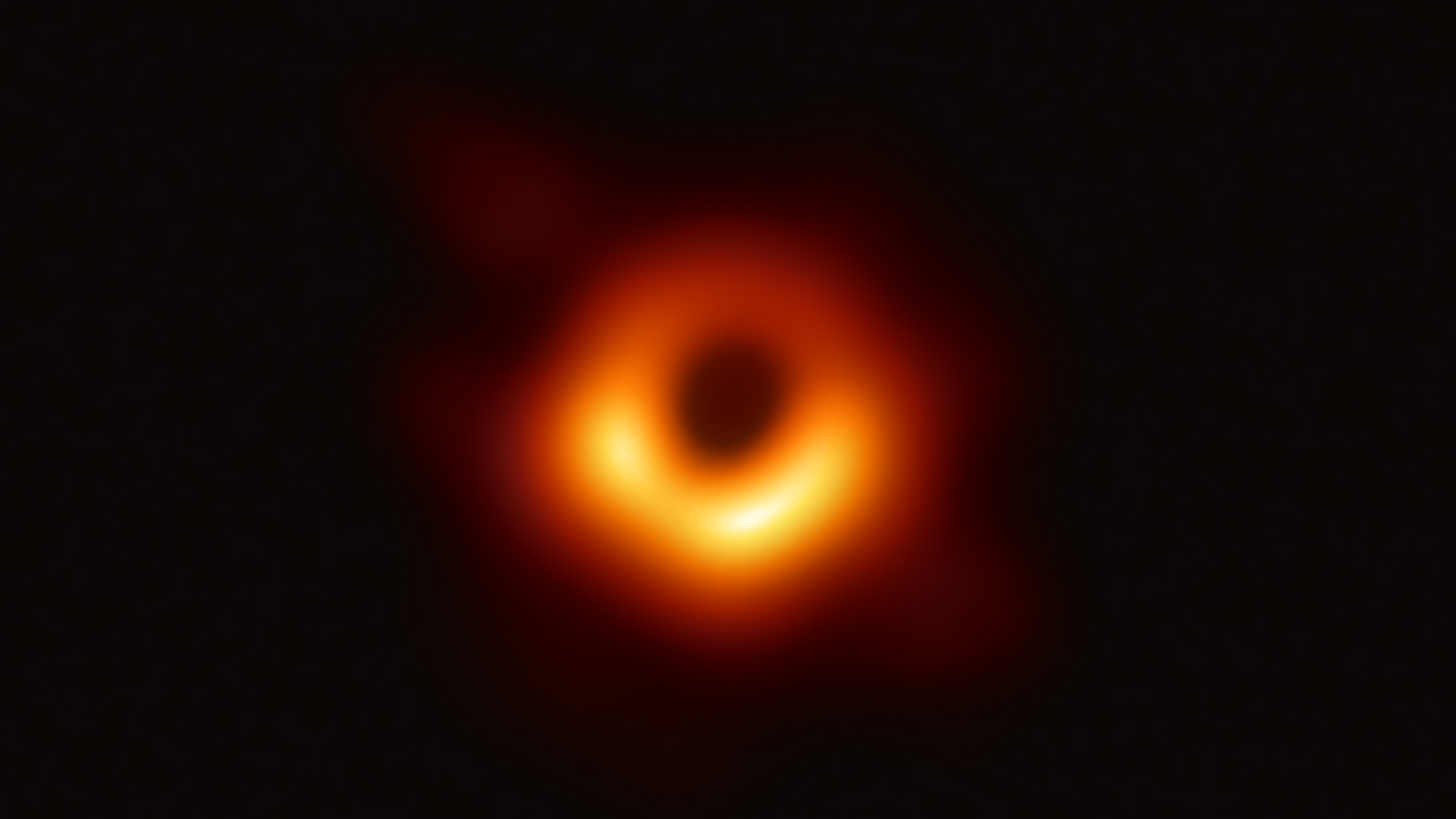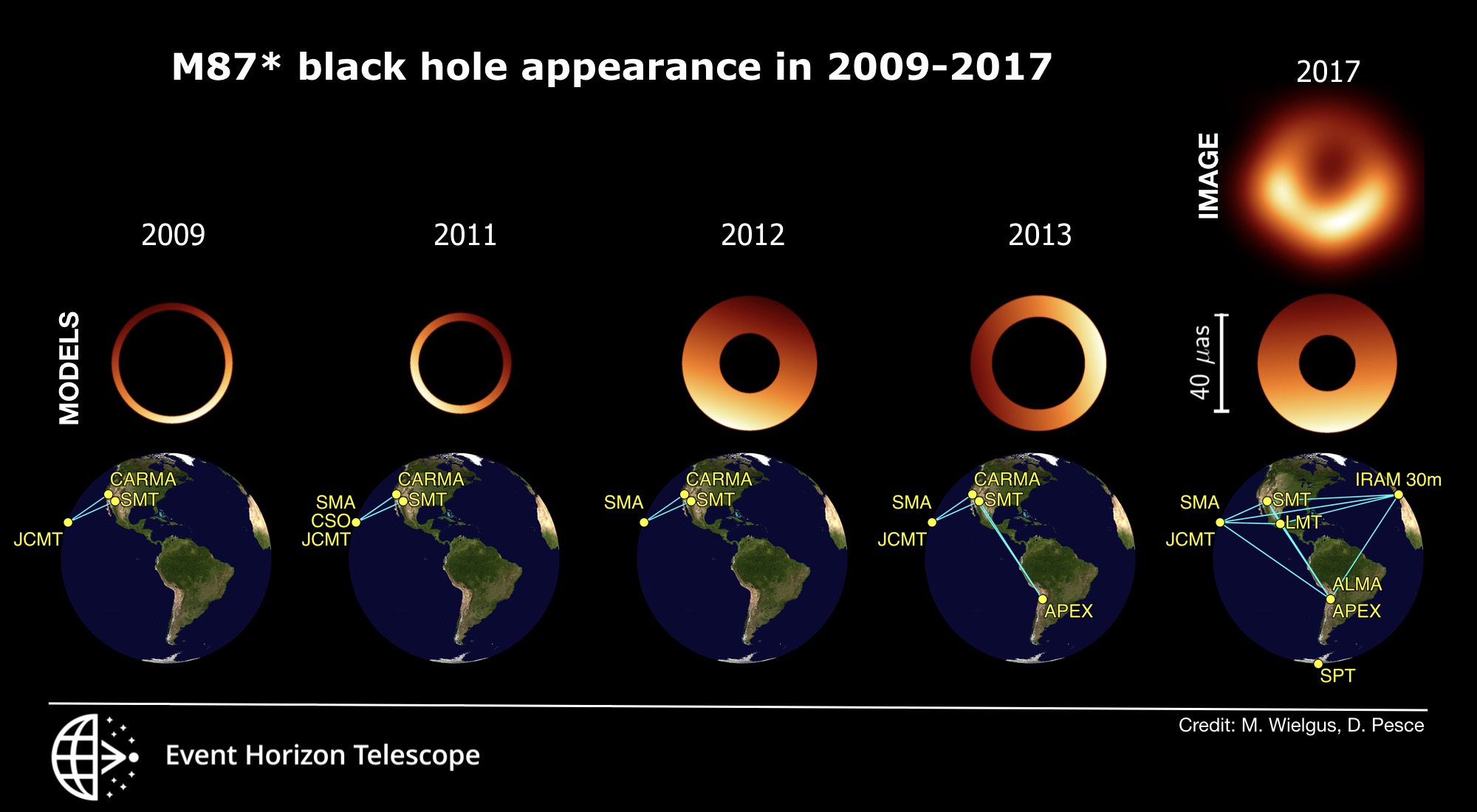
The first black hole to be imaged directly is giving up even more of its secrets.
In April 2019, scientists with the Event Horizon Telescope (EHT) project unveiled a historic photo of M87*, the supermassive black hole lurking at the heart of the galaxy M87, which lies about 53 million light-years from our own Milky Way.
The stunning image shows the silhouette of M87*, which harbors about the same mass as 6.5 billion suns. (It's impossible to photograph the interior of a black hole from the outside; these curious cosmic creatures gobble up everything, even light, that crosses the point of no return, which is known as the event horizon.)
Surrounding the shadow is a bright ring of radiation emitted by fast-moving, superheated gas swirling around, and falling into, the maw of M87*. The ring is far brighter on its "bottom" half, giving the feature a crescent-like appearance.
Related: Historic first images of a black hole show Einstein was right (again)
That landmark view of M87* is a snapshot, capturing the black hole as the EHT saw it during one week in April 2017. In a new study, the EHT team goes back in time, gleaning key insights about M87*'s behavior and appearance up to a decade ago.
The EHT functions like a radio telescope the size of Earth, integrating data from dishes around the globe. The project reached maturity in 2017, and eight telescopes at six different geographical sites observed M87* that April. But the EHT team studied the monster black hole before then, when the telescope was still ramping up to its full strength.
Get the Space.com Newsletter
Breaking space news, the latest updates on rocket launches, skywatching events and more!
The new study takes a look at that old data — specifically, observations from 2009 to 2012, when the EHT had instruments at three sites, and 2013, when the project had expanded to four locales. That early information was too scanty to generate an image, but in the new research, scientists were able to deduce key features of M87* and its surroundings using statistical modeling techniques.
For example, the study team found that the size of M87*'s silhouette has remained consistent over the past decade and is still in agreement with Albert Einstein's general theory of relativity for a black hole of its gargantuan mass.
"In this study, we show that the general morphology, or presence of an asymmetric ring, most likely persists on timescales of several years," co-author Kazu Akiyama, a scientist at the Massachusetts Institute of Technology's Haystack Observatory, said in a statement.
"This is an important confirmation of theoretical expectations, as the consistency throughout multiple observational epochs gives us more confidence than ever about the nature of M87* and the origin of the shadow," Akiyama said.
But not everything stayed the same. Indeed, the new analysis, which was published online today in The Astrophysical Journal, revealed that the bright ring girdling M87* wobbles significantly over time — a result that surprised the EHT team.
"Actually, we see quite a lot of variation there, and not all theoretical models of accretion [of material into a black hole] allow for so much wobbling," lead author Maciek Wielgus, an astronomer at the Harvard & Smithsonian Center for Astrophysics in Cambridge, Massachusetts, said in the same statement. "What it means is that we can start ruling out some of the models based on the observed source dynamics."
Related: Black holes of the universe (images)

The new results are giving astronomers an unprecedented look at black hole dynamics that will enable scientists to test general relativity like never before, study team members said.
"These early EHT experiments provide us with a treasure trove of long-term observations that the current EHT, even with its remarkable imaging capability, cannot match," EHT founding director Sheperd Doeleman, who's based at Harvard University and the Harvard & Smithsonian Center for Astrophysics, said in the same statement.
"When we first measured the size of M87* in 2009, we couldn't have foreseen that it would give us the first glimpse of black hole dynamics," Doeleman said. "If you want to see a black hole evolve over a decade, there is no substitute for having a decade of data."
The current EHT will continue studying M87* and the black hole at the Milky Way's core, known as Sagittarius A*, which contains about 4.3 million solar masses. The project gathers data only during a brief window in March and April, when the weather tends to cooperate at its widespread observing sites.
The EHT's 2020 observing season was canceled because several of the participating telescopes shut down due to concerns about the coronavirus pandemic. But the team plans to bounce back strong in 2021 with a beefed-up array consisting of 11 telescopes.
And there's always more information to analyze, including data gathered during the 2018 season. (It takes quite a long time to integrate, process and interpret observations from the various scopes, as you may have gathered.)
"This is a really exciting time to study black holes!" EHT project scientist Geoffrey Bower, a research scientist at the Academia Sinica Institute of Astronomy and Astrophysics in Hilo, Hawaii, said in the same statement.
Mike Wall is the author of "Out There" (Grand Central Publishing, 2018; illustrated by Karl Tate), a book about the search for alien life. Follow him on Twitter @michaeldwall. Follow us on Twitter @Spacedotcom or Facebook.
Join our Space Forums to keep talking space on the latest missions, night sky and more! And if you have a news tip, correction or comment, let us know at: community@space.com.

Michael Wall is a Senior Space Writer with Space.com and joined the team in 2010. He primarily covers exoplanets, spaceflight and military space, but has been known to dabble in the space art beat. His book about the search for alien life, "Out There," was published on Nov. 13, 2018. Before becoming a science writer, Michael worked as a herpetologist and wildlife biologist. He has a Ph.D. in evolutionary biology from the University of Sydney, Australia, a bachelor's degree from the University of Arizona, and a graduate certificate in science writing from the University of California, Santa Cruz. To find out what his latest project is, you can follow Michael on Twitter.
-
rod This is interesting. The paper cited says this "Applying the same approach to the observational data sets, we find the M87* morphology in 2009–2017 to be consistent with a persistent asymmetric ring of ~40 μas diameter.", https://iopscience.iop.org/article/10.3847/1538-4357/abac0dReply
At a distance of 16.4E+6 pc for M87, 40 mas diameter = 6.56E+5 AU. The 6.5E+9 solar mass black hole diameter ~ 257 AU based upon Schwarzschild radius.









